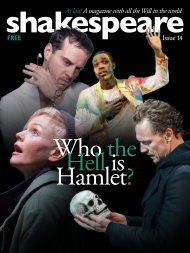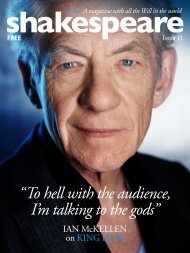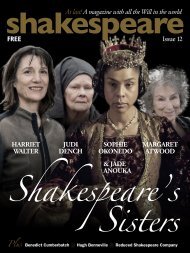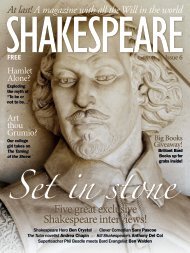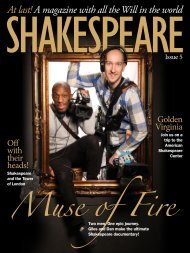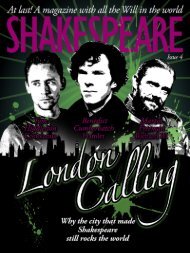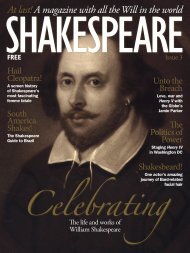Shakespeare Magazine 07
Kenneth Branagh is cover star of Shakespeare Magazine 07, as the issue's theme is Great Shakespeare Actors. Stanley Wells discusses his book on the subject, while Antony Sher reveals what it's like to play Falstaff. We also go behind the scenes of the My Shakespeare TV series, and Zoe Waites chats about playing Rosalind in the USA. Other highlights include Shakespeare in Turkey, Shakespeare Opera, and the real story of Shakespeare and the Essex Plot. All this, and the Russian fans who made their own edition of David Tennant's Richard II!
Kenneth Branagh is cover star of Shakespeare Magazine 07, as the issue's theme is Great Shakespeare Actors. Stanley Wells discusses his book on the subject, while Antony Sher reveals what it's like to play Falstaff. We also go behind the scenes of the My Shakespeare TV series, and Zoe Waites chats about playing Rosalind in the USA. Other highlights include Shakespeare in Turkey, Shakespeare Opera, and the real story of Shakespeare and the Essex Plot. All this, and the Russian fans who made their own edition of David Tennant's Richard II!
You also want an ePaper? Increase the reach of your titles
YUMPU automatically turns print PDFs into web optimized ePapers that Google loves.
The Essex Plot <br />
<br />
<strong>Shakespeare</strong><br />
and Sedition<br />
It’s the much-repeated stuff of <strong>Shakespeare</strong><br />
legend: how the Bard’s theatre company got<br />
tangled up in the 1601 Essex Plot to topple<br />
Queen Elizabeth I. But what really happened?<br />
Words: Francis RTM Boyle<br />
Illustration: Mary Finch<br />
n 7 February 1601,<br />
O<br />
<strong>Shakespeare</strong>’s company, the<br />
Lord Chamberlain’s Men,<br />
stages a command performance<br />
of Richard II at the Globe<br />
playhouse. Robert Devereaux,<br />
2nd Earl of Essex and fallen<br />
favourite of Queen Elizabeth I, arranged for<br />
the special performance and is in attendance.<br />
Richard II, an older <strong>Shakespeare</strong> play, features<br />
the deposition of the weak and vacillating King<br />
Richard II by the Duke of Lancaster – who<br />
steals the throne to become King Henry IV –<br />
as well as Richard’s murder by Henry’s agents.<br />
The next day, 8 February, Essex leads a rebellion<br />
against the Queen. Essex fails.<br />
Months later, on 4 August, after having<br />
Essex and the closest of his co-conspirators<br />
executed, the Queen says the following to<br />
William Lambarde, Keeper of the Records<br />
at the Tower of London, “I am Richard the<br />
Second, know ye not that?”<br />
This sequence of events has led many to<br />
conclude that <strong>Shakespeare</strong> actually conspired<br />
with Essex. Generations of professors, editors,<br />
and theatre artists passed along this theory as<br />
fact. It is a good story, a compelling story; I was<br />
taught it as fact in university, and my thesis<br />
advisor was taught it in Oxford and always<br />
presumed it was true. Unfortunately for the<br />
compelling story, it is simply false.<br />
It is a common maxim among historians<br />
that history is to be studied forwards,<br />
not backwards. If you look backwards at<br />
these events, it is easy to conclude that<br />
<strong>Shakespeare</strong> had a hand in Essex’s rebellion,<br />
and then marvel at <strong>Shakespeare</strong>’s escape from<br />
punishment. Reading history backwards is not<br />
merely poor study, but poor logic.<br />
The “false cause” fallacy states “if B is<br />
preceded by A, A caused B.” The fact that<br />
Essex’s revolt was preceded by a command<br />
performance of Richard II does not prove<br />
<strong>Shakespeare</strong> had anything to do with the<br />
rebellion. The circumstances of 7-8 February<br />
1601 might well be simple coincidence.<br />
SHAKESPEARE magazine 43





